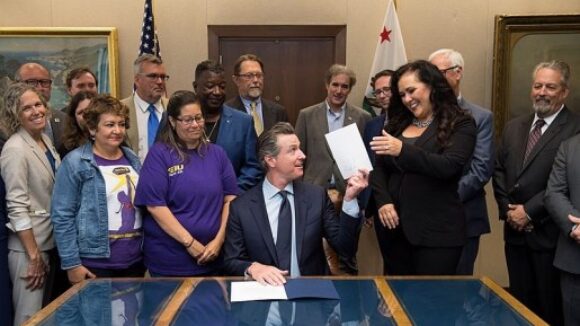‘People Have a Right to Make Their Own Choice’
Avelo employee Kim Howard believes all the firm’s flight attendants should get to vote on continued AFA rule. Credit: WTNH-TV (ABC,…
Georgia, Tennessee and Alabama Benefit From Major New Investments
Although manufacturing employment nationwide continues to fall despite some signs of nascent recovery from the 2008-2009 recession, automotive manufacturing jobs appear already to be on the rise again in states that protect employees from being fired for refusal to join or pay dues or fees to a union.
One leading indicator is the new, billion-dollar assembly plant in Right to Work Georgia that began producing the new, 2010 Kia Sorento crossover vehicle in November 2009.
The plant is located in West Point, a small town on the Chatahouchie river, near its westernmost point (hence the town’s name), and 30 miles from mid-sized Columbus, Ga.
When the plant is fully operational, Kia promises it will provide good-paying jobs for more than 2500 workers. On-site and nearby suppliers will create an additional 7500 jobs in the region.
Big Labor Stronghold States Have Been Losing Auto Factory Jobs For Decades
The number of automotive and automotive-supplier manufacturing jobs has been plummeting in Big Labor stronghold states like Michigan, Ohio and Pennsylvania for decades, not just during the recent recession.
But employment across the sector has been increasing for decades, with only occasional interruptions, in many Right to Work states.
An analysis conducted a couple of years ago by the well-regarded consulting firm Economy.com documented automotive employment trends in all states that had 10,000 or more manufacturing jobs in the sector as of 2000.
Eleven states included in the analysis had Right to Work laws, which protect workers from being fired for refusal to join or pay dues to an unwanted union, throughout the 1986 to 2006 period. They collectively increased their automotive manufacturing jobs from 164,000 to 268,000, or 63%.
And automotive manufacturing employment held virtually steady in Oklahoma, which passed its Right to Work law in 2001.
Meanwhile, aggregate automotive manufacturing employment in the 11 non-Right to Work states included in the analysis fell from 851,000 to 721,000, or 15%, between 1986 and 2006.
Of course, as automotive sales plummeted in 2008 and last year, manufacturing employment in the sector declined nationwide.
New Volkswagen Facility Scheduled to Open Next Year in Chattanooga, Tenn.
But recently automotive companies began making major job-creating investments in a number of Right to Work states in order to take advantage of what they anticipate will be a substantial sales recovery this year.
In addition to Kia’s West Point factory, examples include a new Volkswagen plant in Chattanooga, Tennessee, which is scheduled to begin production next year. Volkswagen expects the plant to generate roughly 2000 jobs.
A third example is Mercedes’ ongoing expansion of its complex in Vance, Alabama. The company will spend $140 million for equipment and process upgrades, including more robotics, in other parts of the facility.
Forced Dues Help Big Labor Implement Tax & Spend, Regulation-Happy Agenda
It’s an obvious fact that auto industry investment in recent years has been heavily concentrated in Right to Work states. But why?
National Right to Work Committee Vice President Matthew Leen observed:
“Right to Work laws mitigate the harm that federally-imposed ‘exclusive’ union bargaining does to employees and businesses.
“In forced-unionism states, union officials have more money and power to advance their legislative agenda, which includes higher taxes, more government spending, and straightjacket regulation of business.
“That’s another reason why veteran site selection consultants whose careers depend on giving sound advice to clients about where to locate or expand their firms view Right to Work as a crucial criterion.
“As national site consultant Bob Goforth has put it: ‘[I]f you’re not a Right to Work state, you don’t play in the game.’“

Avelo employee Kim Howard believes all the firm’s flight attendants should get to vote on continued AFA rule. Credit: WTNH-TV (ABC,…

California’s Big Labor-concocted A.B.5, signed into law by Gov. Gavin Newsom in 2019, made it almost impossible for workers and firms to bounce back after 2020’s COVID-19 lockdowns. Now Biden bureaucrats want to federalize A.B.5!

Mr. Fain undoubtedly knows full well that there is a complete disconnect between the UAW hierarchy and the UAW rank-and-file on the Biden presidency and whether workers will benefit from its extension for another four years.